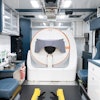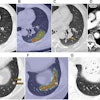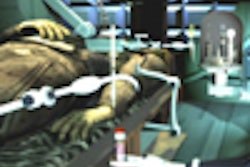With the ever-expanding use of 64-slice CT in cardiac imaging, concerns have risen over patient exposure to unnecessary radiation. Clinicians in particular are struggling with how to reduce radiation dose and still achieve optimum diagnostic imaging results.
Heart-rate control is now a key factor in the debate over cardiac image quality and reducing radiation exposure in cardiac CT. In a presentation last month at Stanford University's International Symposium on Multidetector-Row CT in San Francisco, Dr. U. Joseph Schoepf of the Medical University of South Carolina (MUSC) in Charleston noted that significant radiation dose savings can be achieved through ECG-gated dose-modulation, also known as ECG pulsing.
Most of a CT tube's output is applied during diastole, when images are reconstructed. During that phase, four- and 16-slice CT scanners use a full radiation dose of 100% of nominal output, Schoepf said. "In those phases when you are less likely to reconstruct your images, you reduce your tube current to a mere 20% of the nominal output," he added.
The downside of ECG pulsing is that the technique loses its effectiveness in patients with high, inconsistent heart rates, because that phase of systole -- when CT tube current, or radiation, is reduced -- becomes relatively shorter, Schoepf said. "With higher heart rates, the utility of ECG pulsing largely goes away."
Heart-rate control
That fact, however, has not prevented Schoepf from trying to care for that patient segment. In his practice, he said ECG-gated dose modulation is used routinely with 64-slice CT on patients with steady heart rates of 65 beats per minute or less. Some patients with faster heart rates have received an intravenous beta-blocker (metoprolol tartrate) to control heart rates. Schoepf said the results have been satisfactory and there have been no complications to date.
"If you use rate control to slow down the heart rate, you can grab a large percentage of those patients with fast and irregular heart rates, and bring them back into the group of patients with slow and regular heart rates, where we can successfully use (ECG) pulsing to reduce the radiation exposure," he said.
Much of the success in imaging patients with more rapid heart rates has to do with 64-slice CT technology, which enables clinicians to obtain diagnostics images under those conditions.
Dual-source CT also has been a boon to temporal resolution, compared to the temporal resolution achieved with 64-slice CT, Schoepf believes. The enhanced temporal resolution in dual-source CT has allowed physicians and technologists to more aggressively adapt the ECG pulsing window, so there is a much smaller percentage of the cardiac cycle that receives the radiation dose of the tube-current output.
With better temporal resolution of dual-source CT and the ability to reconstruct images with single-segment reconstruction algorithms, providers can adjust the gantry rotation speed of the scan to the heart rates, Schoepf added.
Public perception
Schoepf also noted that issuing general recommendations for selection of tube-current settings is challenging, because the appropriate tube-current level depends on scanner variables, such as collimated section width and gantry position speed. He recommends adhering to ALARA (as low as reasonably achievable) principles that stipulate CT scanner settings based on a patient's specific condition and the tube current required to still produce a diagnostic image.
Since the general public is not familiar with radiation terms, Cynthia H. McCullough, Ph.D., director of the CT Clinical Innovation Center at the Mayo Clinic in Rochester, MN, told the San Francisco forum that "perception of risk increases to the person when it is something that they can't see, which they can't touch."
How much dose is appropriate for a patient undergoing an imaging scan depends on the procedure. Radiation exposure is generally greater for CT scans than non-CT imaging. Effective dose values currently are under revision, McCullough said, with the International Commission on Radiological Protection expected to release a new set of acceptable values some time in 2007.
Source: Cynthia H. McCullough, Ph.D., Mayo Clinic, Rochester, MN |
||||||||||||||||||||||||||||||||
Of course, the shorter the scan time, the less radiation dose a patient will receive. The use of dual-source CT "can result in significant reductions in radiation exposure," Schoepf said. "If you compare that (dual-source CT) with single-source CT -- even with (ECG) pulsing -- you get radiation doses that are one-quarter what you would receive in the past."
By Wayne Forrest
AuntMinnie.com staff writer
July 6, 2006
Related Reading
Concentrated iodine permits lower volumes in cardiac CTA, May 22, 2006
CT-guided interventions can be performed with less radiation, May 9, 2006
Thermal ablation plus radiation may extend lung cancer survival, March 31, 2006
Percutaneous cryoablation helpful against renal tumors, March 8, 2006
Cautions against CT overuse fall on deaf ears at West Virginia ER, September 27, 2005
Copyright © 2006 AuntMinnie.com




















